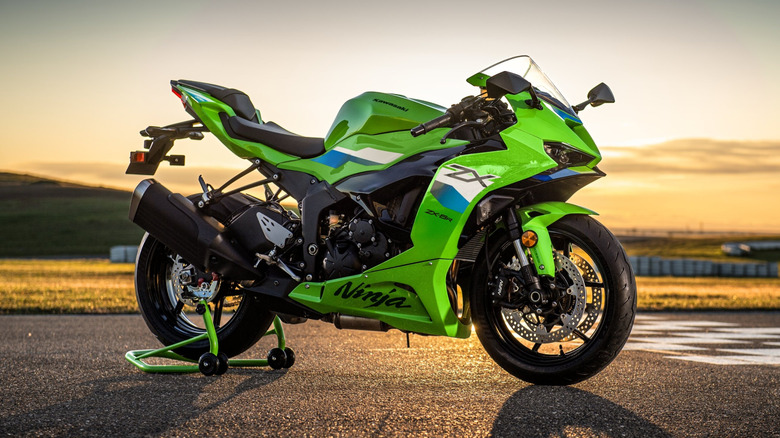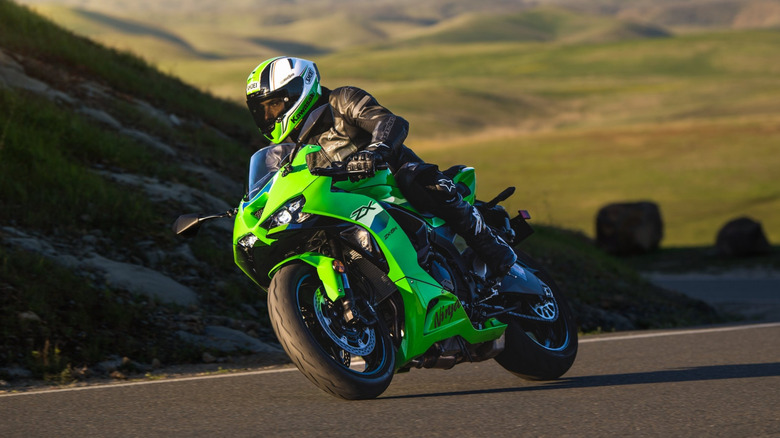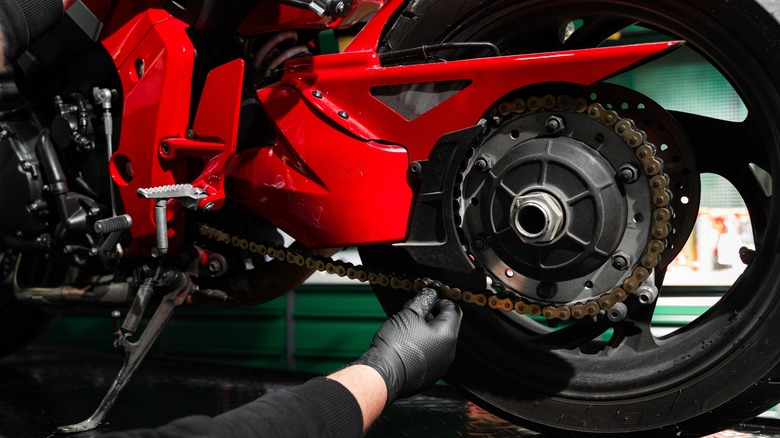How Reliable Are Kawasaki Ninjas? Here's What Riders Are Saying
A motorcycle's price, performance, and pedigree are all part of the equation when you're planning on a purchase. More than just how fast something goes, however, you should also consider a bike's reputation for reliability before buying. Kawasaki currently has a broad lineup of Ninja-branded motorcycles, ranging from its all-electric Ninja e-1, all the way up to the preposterously-fast H2R race bike.
Kawasaki's Ninja bikes have a strong reputation for performance, and we've tested multiple Ninja bikes recently, including two of their strongest performers, the impressive middleweight Ninja ZX-6R and the track-ready Ninja ZX-10R. But how do bikes with the Ninja nameplate hold up over time? Before we dive into some of the details, it's important to know that the Ninja name covers a lot of bikes. There are nearly a dozen different engines currently available in Ninja bikes, so naturally, not all the rider comments and opinions we reference here will apply to every bike.
Owners of smaller Ninjas, like the old Ninja 250 and the 300, say they're seriously reliable. Even with high mileage and after a few low-speed tip-overs, the bikes run well with proper services performed. Larger bikes like the Ninja 650 are also well-regarded when it comes to reliability. Higher-performance Ninjas like the ZX-6R seem to have a good reputation as well. Owners who regularly ride on the track seem to have minimal issues, so long as they stay on top of regular maintenance items, but even the ZX-6R isn't immune from issues.
Some Ninja issues
It's not all sunshine and rainbows with Ninja bikes; a few Kawasaki Ninja bikes have been part of some of the biggest recalls of all time. The Ninja 300, for example, had issues in 2013 where the bikes were stalling during deceleration. Kawasaki remedied that issue by replacing the ECU on the affected bikes, but there's also a more recent recall that's even larger. The current ZX-6R has been recalled for issues with the crankshaft that could cause loss of power. The recall requires some fixes to be completed by local Kawasaki dealers.
According to National Highway Transportation Safety Administration (NHTSA) data, Kawasaki motorcycles have historically low recall rates. Only a few bikes have multiple recalls, and none of the most-recalled Kawasakis wear the Ninja badge. That honor goes to the Kawasaki Concours, and most of that bike's issues seem to be related to its conversion to police duty. Owners of some model years, specifically early-2000s ZX-6Rs, complain of minor oil leaks, but no recall has been issued.
If you dig deep enough in owner reviews and forums, you'll find smaller issues with just about any motorcycle, but no large themes pop up across all Ninja bikes. Instead, it's mostly owners recommending maintenance to keep bikes going strong. Own something long enough and there are bound to be issues with wear items like brakes, chains, and tires, and that's where maintenance comes into play.
Maintenance that will contribute to longevity
Keeping a bike running properly requires a bit of maintenance, but the basic upkeep isn't very difficult on any motorcycle, including most Kawasaki Ninjas of any shape or size. Some simple regular maintenance that you should be doing on your motorcycle includes tire pressure checks, chain maintenance, oil changes, and brake services. And you don't need a bunch of tools to complete these kinds of jobs — even visually inspecting things like the brake pad life is a relatively simple task. Tire pressure gauges are generally pretty cheap, and making sure your tires are properly inflated will make for safer (and more comfortable) riding. Checking the tire pressures when seasons change is especially important, as tire pressure can go significantly lower as the ambient temperatures drop.
Oil change intervals are listed in the owner's manual for every motorcycle, but you can regularly check the clarity and level of your oil. It's definitely a check you should be doing if you ride aggressively or at the track. With a simple motorcycle stand, the right brush, some rags, and a few cans of the proper lubricant, you can easily clean and lubricate your motorcycle chain on a regular basis at home. Doing so will help the longevity of the chain and the sprockets, which are critical to the operation of any motorcycle. Or, if you're not a DIY kind of owner, you can always take your bike to the nearest reputable service center.


